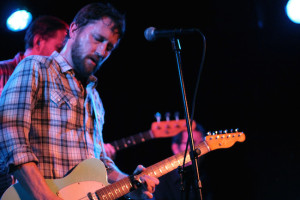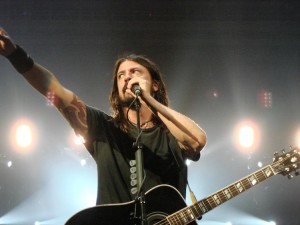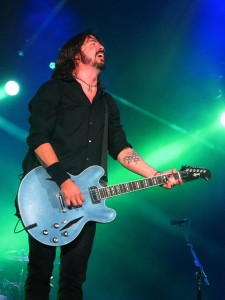Get “That” Guitar Tone: Foo Fighters Edition
A guitar player doesn’t have to be a storied virtuoso to deliver a great tone that countless musicians and fans seek to emulate—or to simply keep in their ears as an extremely useful reference point when they’re in the studio.
For a huge number of younger rock musicians and fans, Dave Grohl and Chris Shiflett of Foo Fighters offer one such point of reference: Their tones, like their songs, are powerful, accessible, memorable, and unpretentious.
Producers and engineers in the know will quickly remind you that “the tone is in the fingers.” And while that’s true, having the right kit can’t hurt either!
So today, we’ll look at both the techniques and the technology that these two humble and effective players have employed to craft some of the biggest, baddest, and best-selling guitar rock tones of the 21st century.
Finally, for those of you working primarily in the box, we’ve included a bundle of amp simulator presets for IK Multimedia’s Amplitube, Native Instruments’ Guitar Rig 5, and Universal Audio’s Friedman Brown Eye 100, to help you recreate some of these tones without spending another dime.
Dave Grohl’s Guitars & Amps
Dave Grohl often used to play Gibson Les Paul Customs on stage, but today he is better-known for his Gibson Trini Lopez Signature Model 335 semi-hollow bodies. This has been his favorite studio guitar since the beginning, and today he’s incorporated it more and more into his live sets.
On these guitars, Grohl uses D’Addario strings with a .10 gauge string on his high-E, and a massive .60 for his low-E, allowing him to get a tremendous amount of bottom end and sustain when riffing in lower registers of the guitar.
Dave has used many amps throughout his career, ranging from Vox AC-30’s and Audio Kitchen amps (used in the studio for Wasting Light) to Mesa Boogie Road Kings and Friedmans. He also uses Marshalls a lot in the studio. To emulate his guitar tone, you may want to consider the following options, whether your rig is hardware or virtual:
Guitars
Ibanez AS73 ($399)
Epiphone Sheraton-II PRO ($699)
D’Angelico EX-DC ($1449)
Gibson Dave Grohl Signature 335 ($3699 in Gold Finish)
Amps
Vox AC10C1 ($449)
Marshall DSL 40 C1 ($699)
Analog Outfitters Sarge ($999)
Mesa Boogie Recto-Verb Twenty Five ($1249)
Friedman Pink Taco 20 Watt Amp Head ($1499)
Chris Shiflett’s Guitars & Amps
On tour, Shiflett frequently uses his signature Fender Telecasters, which feature two humbuckers and a rosewood neck. The Telecaster is an inherently bright guitar, though the custom neck and pickups do fatten up his tone slightly compared to a stock Tele. He runs his signal through a Friedman BE-100 and a plethora of different pedals. Most recently, he has been using a lot of pedals from Strymon MXR, Dunlop, and Boss, some of which we’ll list below.
When I saw the Foo Fighters at one of their club shows in support of Sonic Highways, Chris used a considerably smaller board that focused around a Line 6 M13, though he also used an Xotic Effects EP Booster—a mainstay of his normal touring rig.
The EP Booster is a pedal that is designed to mimic the preamp circuit of an Echoplex delay unit, and guitarists from Eddie Van Halen and Dave Gilmour to Phil X have used this type of preamp sound to enhance their tone. To attempt to replicate Chris’ guitar tone, you may want to consider the following options:
Guitars

Every guitarist has more than one: Chris Shiflett, pictured here playing a standard telecaster with his side project, The Dead Peasants.
Chris Shiflett Signature Fender Telecaster Deluxe ($699)
Amps
Marshall DSL 40 C1 ($699)
Engater Vengeance 120 ($999)
Friedman Brown Eye 100 ($3699)
Effects
Xotic Effects EP Booster ($116)
MXR EVH Phase 90 ($129)
MXR EVH Flanger ($189)
Strymon El Capistan Delay ($299)
Eventide H9 ($499)
Because there are so many great software amp sims on the market nowadays, I thought I’d share some presets for Foo Fighters guitar tones for IK Multimedia’s Amplitube, Native Instruments’ Guitar Rig 5, and Universal Audio’s Friedman Brown Eye 100 amp sim.
Click here to download our custom bundle of Foo Fighters Amp Simulator Settings.
And, because so much of the tone really is in the fingers, here are the 4 tips on how to sound and play like the Shiflett and Grohl:
1) Pick Hard
Dave Grohl has said in multiple interviews that he approaches his guitar arrangements from the perspective of a drummer, and it’s also clear that he likes to physically play the instrument like a hard-hitting rock drummer. He uses medium-heavy gauge Dunlop picks and pretty heavy 10-60 gauge strings so he can really bash the low strings when playing power chords.
Because Grohl doesn’t use a distortion pedal—or really any pedal to boost the amount of gain coming from his amp—his drive tone is contingent upon his amplifier and his picking dynamics.
One advantage of picking harder is that you can get a lot of attack and drive out of your amplifier. Being unafraid to pick harder can also increase the range of dynamics you have to play with as a guitar player, and with the right amp, the tone can break up and saturate more as you dig in. So it’s not only your level that can be dynamic: Your tone can be dynamic too.
The trick here is to avoid setting your amps or pedals so that they’re overly distorted. If you want dynamic crunch, just a little bit of drive—or simply a cranked-up tube amp—is what will help you deliver it.
2) Use the Volume Knob
In the same way that you can control dynamics and tone by simply picking with more or less velocity, you can also alter the dynamics of your guitar playing using the volume knob(s) on your instrument.
When recording guitars directly, you’ll want to be mindful, as you’ll want to record your guitars above the noise floor and below the sound of clipping. (This is much easier to do when you’re recording at 24 bit).
Still, you can get musically interesting results using your volume knobs even in this case, as most amp sims are built to respond to these changes in volume in the way that a real amp would.
3) Use Contrasting Guitars
A painter who has more colors available in his palette can make more captivating art. Similarly when recording multiple guitars, you may want to experiment with recording separate parts with guitars and amps that differ from each other in a significant way.
In the Foo Fighters, Grohl has the “straight up” guitar sound that focuses on the mid range, while Shiflett tends to use a bright Fender Telecaster or Les Paul through a Friedman BE-100. Meanwhile, Pat Smear tends to stick with the heavier guitars and baritone guitars that he runs through Mesa Boogie amps in order to complete the trifecta of guitar frequencies.
If you are not already doing so, try to stick to using a bright guitar/amp combination for your lead sounds, a midrange-focused guitar such as most Gibson hollow bodies for the main guitar riff, and a heavy bass-focused guitar for doubles, power chords, or any chugging tones. This combination is a central component of the powerful and melodic guitar work that Foo Fighters have perfected over the years.
4) Play Out of Tune!
A lot of Foo Fighter guitar melodies utilize moving octaves, such as in the chorus of “My Hero” or the pre-chorus to “Everlong”. In order to add depth to these types of guitar melodies, sometimes Dave may bend one string slightly out of tune.
This is an effect that has been used and adapted throughout guitar rock history, notably by Jimmy Page on the riff to “Whole Lotta Love”, where he would play the D string and simultaneously hit the D note on the 5th fret of the A string and bend it slightly out of tune.
I hope you enjoyed these suggestions. And now, armed with all of this knowledge, go and play some Foo Fighters songs! Or, take these insights from one of the most effective and widely-adored guitar rock groups in recent memory to craft your own unique tones.
For more great insights into both mixing and mastering, try our full-length courses with SonicScoop editor Justin Colletti, Mixing Breakthroughs and Mastering Demystified.


Please note: When you buy products through links on this page, we may earn an affiliate commission.









Captain Betty
October 29, 2015 at 12:06 pm (10 years ago)Good article, but only half the battle. The other half is how that tone is captured be it live or in the studio. Miking techniques play a huge role.
Alan Seeger
October 29, 2015 at 2:49 pm (10 years ago)What about Pat Smear?
Peter Juliano
November 12, 2015 at 3:42 pm (10 years ago)A huge factor … the room and the mics … you need to be in a room where you can push some air (even if close micing) .. then the MIC pairing .. Royer 121 & SM57, Sennheiser 421 & SM57 .. or other combos like the one I am using now .. Josephson E22s with an AEA N8 … then the PREAMPS .. Neve or API for rock
Michael
November 29, 2016 at 8:37 am (8 years ago)Great job putting all this together and a great starting point to work towards getting a similar tone.